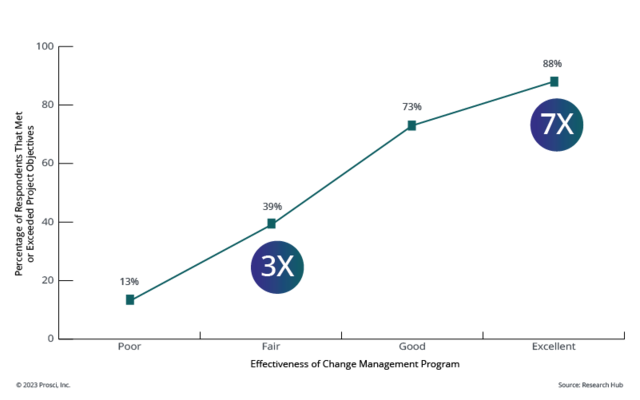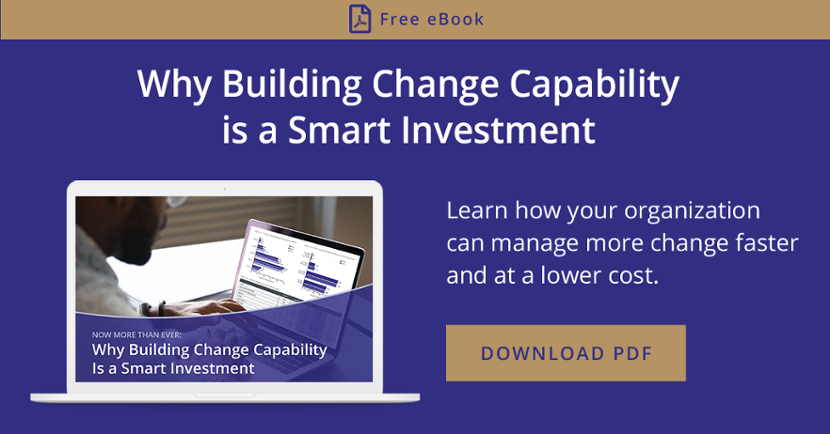Why Your Organization Needs Enterprise Change Management

4 Mins
Updated: March 31, 2025
Published: April 21, 2021

Project teams today increasingly recognize the need to manage the people side of change on individual projects, but that isn’t enough for some organizations. The growing amount and complexity of change their organizations face is a challenge, yet they see an opportunity. These organizations are deploying enterprise change management and realizing next-level benefits that yield competitive advantages. What do they know that others may not?
Enterprise Change Management
Is Different
Prosci defines project-based, organizational change management as the application of a structured process and set of tools for leading the people side of change to achieve a desired outcome. This improves outcomes and return on investment (ROI) on projects by enabling impacted individuals to move through their individual transitions, so they can adopt and use project solutions in their day-to-day work.
Enterprise change management differs in that it delivers strategic intent, mitigates change saturation, and improves agility by embedding change management into the fabric of the organization. This requires building change management competencies across the entire organization in addition to ensuring effective change management on all projects and changes within the organization.
Generally, three key elements are present in enterprise change management:
1. A common set of processes and tools for managing change
This means applying a consistent process and set of tools for managing the people side of change across all the changes going on in the organization. It’s the repetitive and intentional application of change management.
2. A leadership competency at all levels of the organization,
from front-line supervisors to senior executives
While the first element ties to projects, the second element ties to the people in your organization. Leadership competency means that all the leaders, managers and supervisors in the organization internalize the role and responsibility for leading change. Achieving this requires training, coaching, and on-the-job support.
3. A strategic capability that enables the organization to be flexible,
change-ready, and responsive to marketplace changes
This is an outcome of the first two elements. When the organization applies change management to many projects and when individuals build the needed expectations and skillsets, the organization can count "change-ready" as one of its core competencies.

Enterprise Change Management Requires Different Treatment
In addition to the elements above, moving from a project-only approach to enterprise change management is its own endeavor for the organization. There is no magic wand or silver bullet to help an organization become competent at managing change. When your organization becomes serious about building this core competency, you must also shift your perspective about change management, which involves viewing and treating it differently as follows:
As a project
Like any project, the effort to build the change management competency requires planning, design and implementation work. To be successful, you need a structured approach to managing the project, along with the resources and plans for implementing your competency-building project.
As a change
For many in your organization, building enterprise change management requires new behaviors, activities and skillsets. Managing the human component of this will be crucial to your effort’s success. This includes communication, sponsorship, and the other tools for managing human reactions to your competency-building effort.
As a top-down effort
Enterprise change management must be driven from the top of the organization. In every Prosci Best Practices in Change Management study, active and visible sponsorship from senior leaders is the number one contributor to success. Building the organizational competency to manage change is no different. You must have a primary sponsor, a strong sponsor coalition, and communication directly from senior leaders about the need for managing change as an organizational competency.
Why Enterprise Change Management?
Now that you understand the differences between change management and enterprise change management, consider the big question: Why should your organization make the move toward building enterprise change management competency?
Three important reasons should fuel your response. First, your organization receives cumulative benefits from change management across multiple projects. There are also benefits that only emerge from the enterprise perspective of deploying change management. And of course, there are benefits that come from being better as an organization at responding to the external drivers of change.
Cumulative benefits
Prosci research shows a direct correlation between change management effectiveness and meeting objectives, finishing on schedule and staying on budget. The easiest answer to why your organizations needs enterprise change management is that these benefits can be multiplied across all the projects in the organization.

Similarly, the negative impacts of poorly managed change include productivity declines, passive resistance, disengaged employees, attrition, active resistance, arguments, slow adoption, workarounds and divides between “us” and “them.” Change management provides structure to mitigate and resolve these issues.
Enterprise perspective
Effective change management also makes achieving project objectives and return on investment (ROI) more likely. When you implement effective change management on all projects and at all levels of the organization, the entire organization is more likely to implement all changes more effectively.
 Some of this benefit comes from consistency. Instead of reinventing the wheel for each new change project, enterprise change management delivers a consistent change management methodology and approach. This consistency also enables continuous improvement of the approach, tools and training, while creating a common language about change to be spoken throughout the organization.
Some of this benefit comes from consistency. Instead of reinventing the wheel for each new change project, enterprise change management delivers a consistent change management methodology and approach. This consistency also enables continuous improvement of the approach, tools and training, while creating a common language about change to be spoken throughout the organization.
The same idea applies to using common and shared resources on multiple projects or across different areas of your business. When multiple approaches exist, there is a real risk of colliding with other change efforts throughout the organization and having frustrated leaders disengage from all activities as a result.
External drivers of change
Externally, marketplace drivers support building the organizational competency to manage change. First, the sheer amount of change that organizations face today continues to grow. Change has become ubiquitous across industries and throughout the world. So much change makes building the competency to manage it a necessity for growth, innovation and survival. Most organizations simply cannot risk the negative impacts from failing to execute on the changes they must introduce over the next several years.
Finally, traditional sources of competitive advantage that organizations have long relied on are eroding. How quickly and painlessly your organization can adapt to change is central to differentiating you from competitors in the coming years.
Enterprise Change Management Competency
Many organizations know that change management is essential to ensuring adoption and usage of critical project changes. After finding success with the project-based approach, some organizations are ready to enter a new phase and reap even more benefits. By building enterprise change capabilities, these organizations are making change management a core competency, creating competitive advantages, and ensuring a change-ready future. Are you ready to join them?



